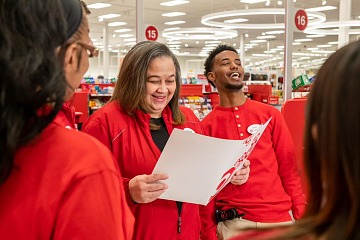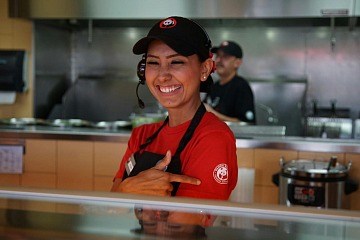Diversity & Inclusion, Employee Experience, Gen Z, Generations at Work, Millennials in the Workplace
Managing a multigenerational workforce involves viewing everyone as an individual, developing mentoring relationships and checking your communication methods.
It’s a long-standing joke that every generation is suspicious of the one coming after it, while rolling its eyes at those who came before. And, of course, there are stereotypes galore: Boomers are terrible with tech. Gen Xers hate everything. Millennials are entitled.
But when it comes to engaging a multigenerational workforce, leaders must toss those jokes and stereotypes aside.
True, there is some personality psychology to each generation. The world events, economic conditions, trends, and cultural norms of each era have influenced how people of each generation think and behave.
But individuals don’t slot into neatly defined categories. Some millennial employees adopt traditionalist behaviors, and Boomers who show Gen Z traits. Making generational assumptions isn’t just unrealistic — it’s risky.
What is a multigenerational workforce?
A multigenerational workforce is one in which the employees span different generations. There are now five generations in the workforce simultaneously (Gen Z, millennials, Gen X, baby boomers and some members of the silent generation still working in their late 70s and early 80s) – a first in modern history. This means an employer today could easily have young graduates working side-by-side with great-grandparents.
For managers of multigenerational workforces, engaging all generations is essential — not just for employee satisfaction but also for the company’s overall success. Diverse and inclusive workplaces have higher employee retention, higher revenue growth, and a greater readiness to innovate.
4 multigenerational workforce challenges (and how to overcome them)
The days of one-size-fits-all management are long gone.
Workplaces are becoming more ethnically and racially diverse (Gen Zers, also called zoomers, is tracking to the be the most diverse workforce yet, with 47% identifying with a group other than white, according to Great Place To Work® data), and employees from up to five generations work side by side.
The range of priorities, expectations, and experiences that employees bring to the workplace is wider than ever.
For example, what Gen Z wants from employers are workplaces that are mentally healthy and safe and offer diversity and inclusion, whereas the biggest predictors of employee retention for millennials are company reputation, purpose, and connection.
Here are some of the most common challenges of a multigenerational workforce, and how to overcome them:
1. Differing priorities
With a multigenerational workforce, employees span the full range of life stages. Some may be raising young kids, while others are caring for ailing parents. Some may be in new relationships, while others are going through a divorce. Some may be shopping for their first home, while others are researching retirement options.
The key is not to recognize one as more important than the other.
Leslie Patterson, diversity, equity & inclusiveness leader, Americas and US with EY, points to flexibility for working parents as an example. While offering such flexibility is great, it can’t be exclusive to employees with families.
“When I was younger, I wanted to work out. I was single, no kids,” she says. “If you thought about the whole hierarchy of what everyone had to do, mine was probably the least important… And so, how can we handle one’s personal needs? We are still going to accomplish the project, but you want to work out on Tuesdays, I want to go to Bible study on Wednesdays.”
2. Stereotypes and assumptions
Just as we should never stereotype based on race, ethnicity, gender, or sexual orientation, we shouldn’t stereotype age and generation.
Generational acceptance and sensitivity should be part of any company’s diversity, equity, inclusiveness & belonging (DEIB) initiatives, for both managerial and peer-to-peer relationships.
Part of avoiding stereotypes is acknowledging and exploring the overlaps that may exist between generations. Perks targeted to one generation might end up being ideal for everyone.
Just as we should never stereotype based on race, ethnicity, gender, or sexual orientation, we shouldn’t stereotype age and generation.
For example, it’s a common assumption that boomers are keen to return to the office post-Covid, while the younger generations want to stay remote or hybrid. However, workplace flexibility has proven to be a universal desire across all the generations.
3. Miscommunication
How we communicate has dramatically changed over the years, and everything from slang to style to format (phone, email, text, emojis 👁️👄👁️) can affect how employees interpret messages.
For baby boomers who mastered phone calls and in-person meetings for most of their careers, texts and Facetimes may feel jarring. For Gen Zs used to quick DMs, saying "it would be quicker to pick up the phone," won't necessarily resonate.
Older generations adapted letter writing to create email style. For zoomers, letter writing is unfamiliar.
With most generations preferring written communication, there can be misinterpretations of tone and punctuation.
Take the common period, for example. Gen X or Boomers may view sentences without periods as unprofessional or sloppy. For zoomers, they may consider periods as passive-aggressive or cold.
Setting rigid communication rules won't resolve communication gaps between generations. Communicating in just one style leaves generations out of your correspondence.
If you're managing a multigenerational workforce, communicate using multiple methods. Savvy managers will take note of how each individual responds to different communications.
These managers will email, use messaging, texting as appropriate, and have face-to-face meetings to connect with their workforce. Regardless of generation, most people respond well to hearing a critical message more than once, too.
4. Us vs. them attitudes
Younger generations may feel nervous asking questions of their older colleagues, or feel like they need to prove themselves. Older generations may feel the need to coddle younger colleagues, or may simply dismiss them as inexperienced.
“If you don’t know this person, if you feel they are generations ahead — the ages of your parents, uncles, aunts, whatever — there’s a fear of asking for clarification,” says Leslie.
The key to avoiding this power dynamic, she says, is trust, which employees gain by getting to know one another as not just colleagues, but as people.
Managers of multigenerational workforces should keep an eye out for such power dynamics, especially in meetings. If it appears that an employee’s contributions to a discussion aren’t being taken seriously, this is a good opportunity to be an ally and make space for them to speak up.
You could say, “I know Austin had some thoughts earlier. Would you like to share, Austin?”
Remind staff that it’s good to have a variety of opinions and that you are collaborating, rather than competing against the old guard or young blood.
How to engage a multigenerational workforce
Keeping your multigenerational workforce engaged and productive is all about trust and communication. Here are some ways to ensure every generation feels seen and heard:
1. Have regular check-ins
Make it a habit to check in regularly with employees — and be sure to make your check-ins not just about work, but about life.
Learning about what is happening in each employee’s life will not only create trust in the workplace, but also make it easier to offer benefits that specifically suit them, rather than simply being a blanket perk for their generation.
2. Clear up miscommunications
Language evolves, and it’s easy for employees from different backgrounds or age groups to have vastly different interpretations of a message. Ensure that everyone understands different communication styles and how they can be misinterpreted.
Learning about what is happening in each employee’s life will not only create trust; it will also make it easier to offer benefits that specifically suit them, rather than being a blanket perk for their generation.
But tread carefully: while it's important to understand generational differences, it's equally vital to ensure this knowledge doesn't turn into ageism. Each person – no matter when they were born – has their own communication preferences.
3. Capitalize on each generation’s skills and knowledge
Every generation brings a unique life experience to the workplace, from the skills they learned in school to the world events they witnessed. Find ways to help each generation thrive in the areas they already know, as well as to learn new skills from the generations before and after.
For example, social media is often flagged as something that younger generations raised on memes can teach to older generations. However, knowledge transfers can go both ways. For Gen Z, who entered a remote workforce during the pandemic, interpersonal skills like negotiating, networking or speaking confidently in front of crowds are proving to be a challenge — and something they can learn from their older colleagues.
Develop a mentorship program where more senior employees can nurture and guide their younger coworkers. This two-way exchange not only gives younger generations the feedback they crave, but it also helps people connect and see past pre-conceived differences.
4. Skip the stereotypes
Some boomers are tech-savvy. Some millennials dislike working remote. Gen Z employees can be new parents. While there are common characteristics and life stages for each generation, there are also endless variations within each one.
Encourage open and honest conversations in the workplace about age stereotypes. Create opportunities for employees to collaborate and socialize across the generations and beyond their usual team or social circle.
Non-hierarchical check-ins and mentorships (both older-to-younger and younger-to-older) will give employees the opportunity to share stories and perspectives and foster understanding across the generations.
5. Provide inclusive benefits
Some benefits, such as fertility benefits and parental leave, are generally (although not exclusively) geared to one generation. But there are countless ways for employers to ensure their benefits span the full age range of their employees.
For example, you could provide paid time off for pet owners who don’t have “traditional” caregiving needs but need to care for a sick pet. Or you could offer educational benefits, like Sheetz’s tuition reimbursement program that reflects what Gen Z really wants from employers.
6. Be a leader for all
Our research has found that each generation wants different things from its leaders. For example:
- Millennials desire managers who can connect employees to a common purpose
- Gen Xers want leaders to be role models who can roll up their sleeves and problem-solve in challenging times
- Boomers view leaders as strategic thinkers who are admired, yet distant
For managers of multigenerational workforces, it’s important to keep these expectations top of mind. While it’s impossible to be everything to everyone all the time, having an awareness of what each generation wants in a leader, and striving to meet those expectations, will ensure each generation stays engaged.
Looking ahead to the next generation of workers
While generational trends will continue to drive workplace recruitment and retention strategies, our top priority should always be to engage each person as a unique individual fully.
With more generations than ever working side by side, employers are positioned to create strong, innovative teams rich with diverse thought, experience, and expertise. Look at the best traits that each generation — and each individual — brings to the table and then adapt accordingly.
Manage a multigenerational workforce
When you become Great Place To Work Certified™ you will build a better employer brand and get the data and analysis about your workforce to make informed talent management decisions. Understand how all your employee groups are experiencing your workplace culture and what your employees want. Ask us about the Certification process today.














